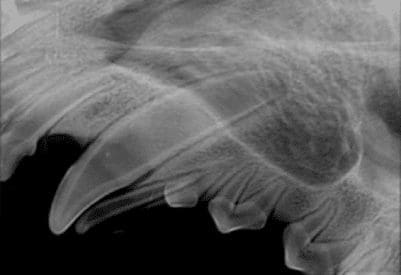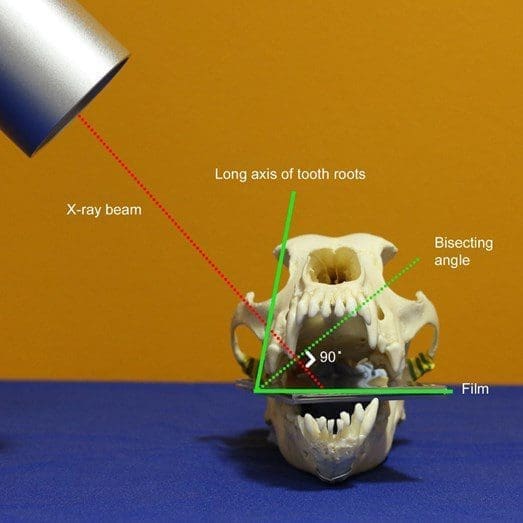How many dental radiographs do you take; lots, some, a few or none?
(written by Lynda Dunbar)
Oral examinations only tell us part of the dental story. Prior to radiography, we can assess the tooth’s clinical crown and gingiva, but not a great deal more. Information gained by performing dental radiographs is invaluable – not just for extractions, but for every dental procedure.

Fig 1. Assessment of retained deciduous canine using dental radiography.
Without thorough dental examinations including radiographs, vital information could be missed that may affect your clinical decision making.
Dental radiography can also help reduce the time and stress of dental procedures. If you know what you are dealing with from the start, the likelihood of causing iatrogenic trauma is greatly reduced. E.g. time can be saved by choosing to perform a simple crown amputation of a type 2 FORL, therefore avoiding unsuccessful root removal attempts and unnecessary trauma. Identification of areas of bone loss can help differentiate underlying causes such as neoplastic disease, advanced periodontal disease or a cyst. It is also possible to identify early periodontal disease before it becomes severe, therefore preventing painful conditions or even pathological jaw fracture.
Full mouth dental radiography should not be time consuming or expensive. So why, as a profession, do we generally shy away from it?
Cost and time are often cited as issues. The good news is that dental radiography is not cost prohibitive and can be achieved with standard x-ray equipment. Dental films cost as little as 30p per film or around £1 for self-developing films. Almost every practice in the UK will have a standard generator which can be used for dental radiography. Granted, it’s not as easy as having a dental generator (you need to position the animals head rather than positioning the generator) but it is possible to get started.
Charging as little as £30 for a set of dental x-rays (a basic full mouth consisting of around 6-8 films) quickly generates revenue. Based on this, a single vet performing two routine dental procedures a week (including full mouth radiography) would generate over £3000 a year from dental x-rays alone.
Dental radiography should also strengthen the vet-client bond and give the client a sense of value for money. If dental work is perceived as expensive, x-rays can help illustrate the severity of dental disease to the client. In human dentistry, teeth would always be radiographed before extraction so it is usually well understood as a necessary part of the dental procedure.
How time consuming is full mouth radiography?
In a ‘normal’ situation, the anatomy of interest is positioned parallel to the plate and the x-ray beam is perpendicular to the plate. The maxilla and the hard palate make positioning equipment using this technique impossible if you are trying to image the incisors or obtain lateral views of the maxillary canines, pre-molars or molars.
Dental radiography requires the use of the bisecting angle technique. The aim is to use a bisecting angle to project an image onto the film, aiming for a ‘life-sized’ accurate image of the tooth to retain the accuracy of any pathology.
The generator is positioned to project the x-ray beam perpendicular to the bisecting angle between the long axis of the tooth and the plate (see figure 2).

Fig 2. Radiography of right maxillary molars.
Taking a set of full mouth dental radiographs should not be time consuming. With the right equipment, technique and a bit of practice a full mouth should be easily achievable in a matter of minutes.
Routine dental radiography should be exactly that; routine. Not only does it illustrate a high standard of patient care but offers clinical justification for work performed and acts as a screening tool to eliminate disease that cannot be visualised on oral examination.
Ask your local account manager for more information about using your radiography equipment for dental x-rays.